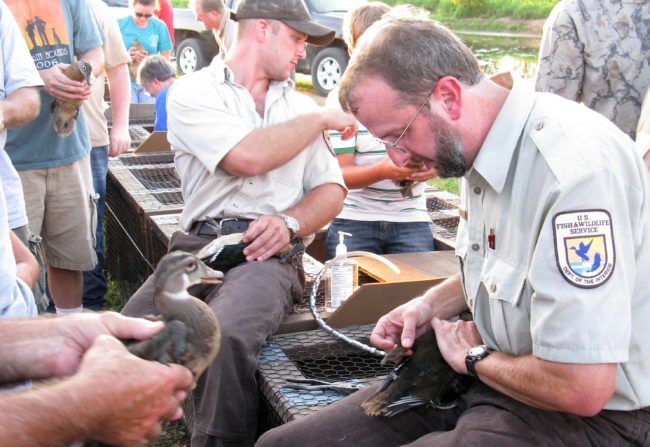
Springville, Tenn.–Far away from population centers in rural West Tennessee, U.S. Fish and Wildlife Service biologist Clayton Ferrell quietly broke a long-standing record.
In the middle of a 51,000-acre wildlife conservation area called Tennessee National Wildlife Refuge (NWR) sits on one of the most productive bird banding stations for wood ducks in the nation. Each July and August refuge staff and volunteers under the guidance of Biologist Ferrell strive to put a metal numbered band on as many wood ducks as they can catch. Attempts for a quota of several hundred wood ducks are usually met, however, this year was a banner year.
With the number of banded wood ducks already running high this summer, that annual quota was reached early in the season. On the last day of August, his banding team tried one last time to break the all-time record which was set in 1991 of 1,588 wood ducks banded in one summer season. They needed 216 new birds banded that evening to set the new record.
It was the habit of this veteran waterfowl biologist to give an early check on his baited banding site using a powerful monocular called a spotting scope. He could see the trap was extremely full of birds, and filling with more. However, all was ready with an assembled team that included refuge staff, Tennessee Wildlife Resources Agency waterfowl biologist, Ducks Unlimited members and trained volunteers. The evening ended with a catch of over 1,100 wood ducks, which was a single day catch record! Even after a few were accidentally released before the band was put on, exactly 216 new birds were banded putting his season total at 1,600 banded wood ducks, which is more than any recorded at one location in the nation!
In fact, over the last 30 years under Wildlife Biologist Ferrell’s direction, Tennessee NWR has banded more than 25,000 wood ducks, which is more than any other banding station in the country!
Looking back at over 30 years of working on Tennessee National Wildlife Refuge and even more volunteering at Cross Creeks National Wildlife Refuge, this feels a bit of a crown jewel on his life’s work focused on waterfowl conservation and habitat management. He has explained to many over the years that biologists have been banding migratory birds for decades in order to gather valuable information about migration. Banding also provides clues about waterfowl harvest levels and a bird’s longevity.
Because the band has a unique number assigned only to that bird, a band on the leg turns a generic bird into an individual that can be tracked. All information such as age, sex and condition of the bird is recorded along with the band number in a national database managed by the “Bird Banding Lab”. If anyone harvests or finds a banded bird, they can report that band number at www.reportband.gov to receive a certificate with all that specific bird’s information.
The Tennessee National Wildlife Refuge has had a long history with banding waterfowl, raptors and songbirds for wildlife research since 1949. Over the years many different US Fish and Wildlife Service staff, student interns and volunteers have contributed to this refuge’s banding effort. The refuge has banded many different species of waterfowl, raptors and songbirds. For many years in the past Biologist Ferrell also conducted a M.A.P.S. station which stands for Monitoring Avian Productivity and Survivorship. During the spring breeding season, songbirds were captured with a mist net, and then banded.
“Clayton has mentored and trained hundreds of volunteers and interns over the past thirty years” said Troy Littrell, Deputy Refuge Manager. “He is one the most experienced waterfowl biologists for the Fish & Wildlife Service and after 30 years on the job he continues to bring a passion and love for his work that is evident. Each summer he shares this passion and love for the resource with a new generation of future wildlife biologists and managers.”
We celebrate all conservation biologists that work so hard for the welfare of our nation’s wildlife species, but we especially celebrate the huge success of Clayton Ferrell and his record setting wood duck banding program.
Photo: U.S. Fish and Wildlife Service waterfowl biologist Clayton Ferrell works to band wood ducks while training another group of wildlife students from the University of Tennessee at Martin. Photo by Joan Howe, circa 2021.



